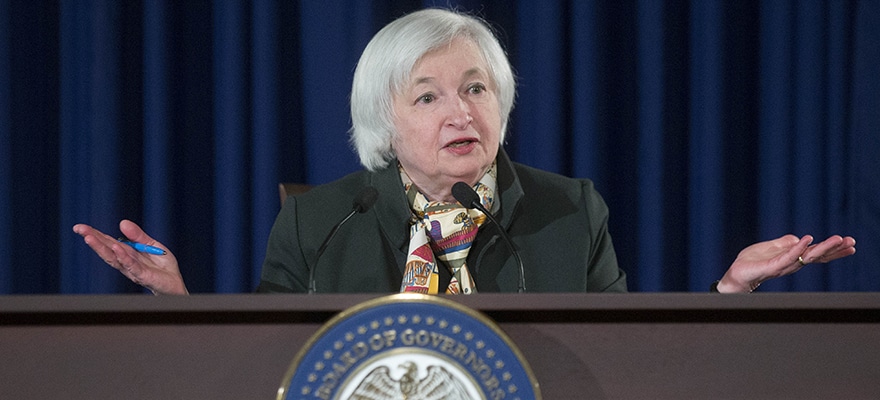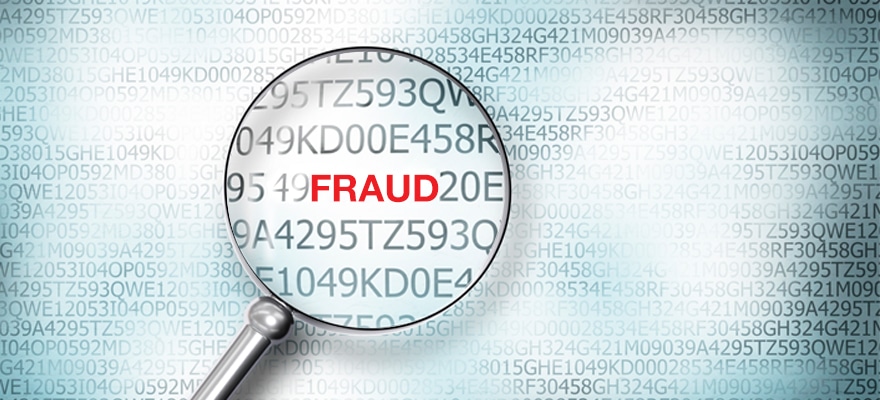The Federal Reserve has finally ended the waiting game and lifted the benchmark interest rate by 0.25% yesterday, the first rise for nearly a decade.
With the financial markets largely anticipating the move, much of the rate rise was priced in across asset classes. But it also signals an end to an era of cheap money.
Fed chair Janet Yellen said during a press conference that the action “marks the end of an extraordinary seven-year period during which the federal funds rate was held near zero to support the recovery of the economy from the worst financial crisis and recession since the Great Depression.”
Experts warn that perhaps the markets have priced in too much, too fast
She also cautioned: “It’s important not to overblow the significance of this first move,” - a tone that has experts warning that perhaps the markets have priced in too much, too fast.
Emma Dinsmore, CEO of r-squared macro, a systematic global macro fund, said that waiting for market expectations to get in line with reality was part of the Fed’s intention to avoid shock.
Still, there are yet expectations to manage.
“It is quite concerning that markets today are pricing in (just over one hike) next year. That is not what the Fed is saying,” said Dinsmore. “It seems like somebody’s going to have to budge.”
Future signals
Since the Fed will remain data dependent, signals to watch for include risk sentiment staying intact, and inflation accelerating at an orderly rate, said Ankur Patel, CIO at r-squared and a former lead trader at Bridgewater.
Warning flags for the Fed could be events such as equities selling off 10% to 15%
“You’d see a disorderly response if all of a sudden the rate hike filtered into the economy and led to much slower growth, or, on the other side, if inflation picked up in a material way that would also be concerning because that would cause the Fed to raise rates at a more aggressive pace,” Patel said.
Warning flags for the Fed could be events such as equities selling off 10% to 15%, the bond yield curve moving by 100 basis points, or the US dollar shrinking by 5% to 10%.
“If something like that were to occur then I think the Fed would adopt a much more dovish stance, but barring such a scenario, the Fed is going to work through any short term Volatility
Volatility
In finance, volatility refers to the amount of change in the rate of a financial instrument, such as commodities, currencies, stocks, over a given time period. Essentially, volatility describes the nature of an instrument’s fluctuation; a highly volatile security equates to large fluctuations in price, and a low volatile security equates to timid fluctuations in price. Volatility is an important statistical indicator used by financial traders to assist them in developing trading systems. Traders
In finance, volatility refers to the amount of change in the rate of a financial instrument, such as commodities, currencies, stocks, over a given time period. Essentially, volatility describes the nature of an instrument’s fluctuation; a highly volatile security equates to large fluctuations in price, and a low volatile security equates to timid fluctuations in price. Volatility is an important statistical indicator used by financial traders to assist them in developing trading systems. Traders
Read this Term and really just hope that the rate hike does not lead to deceleration in growth,” he said, adding that if things do go smoothly, the Fed could raise rates again sometime in the first half of next year.
Oil, inflation and the USD
Just taking the uncertainty of the first rate hike off the table is a very positive development for the markets, said Jeremy Siegel, Senior Investment Strategy Advisor at WisdomTree, an ETF provider.
Going forward, Siegel predicts that March 2016 will be the first meeting at which another rate hike will be considered.
“There’s going to be an awful lot of discussion. I think it’s going to be a very, very close vote [but] it’s not a slam dunk by any means,” Siegel said.
For USD to strengthen meaningfully, the Fed would have to be in aggressive hiking mode in 2016
Part of the reason for the hesitation is the stubbornly low oil price. Although the Fed looks at core inflation, which does not include food and energy, the dramatic and sustained fall in oil affects a lot of goods and services, he explained.
So far, the market seems to have taken the decision well, with equities rallying and a relatively low amount of volatility in FX, said Saeed Amen, co-founder and quant strategist at The Thalesians, a think tank.
For the US dollar (USD) to strengthen meaningfully from here, Amen added, the Fed would have to be in aggressive hiking mode in 2016, which seems unlikely. “We are getting closer to a point of inflexion, where the broad based USD bull trend could fade and begin to turn. Consensus is generally not as bullish USD.”
Rates and global markets
French investment bank Société Générale identified three key indicators to watch: wage growth in the US for long term bonds, US financial conditions for equities, and potentially wider spreads hitting emerging market corporate credit.
There’s been plenty of speculation on the impact of the rate hike on emerging markets (EM), particularly after the “taper tantrum” of 2013, when they sold off, causing a contagion effect, after the Fed started phasing out quantitative easing.
SocGen said in a client note that while EM Leverage
Leverage
In financial trading, leverage is a loan supplied by a broker, which facilitates a trader in being able to control a relatively large amount of money with a significantly lesser initial investment. Leverage therefore allows traders to make a much greater return on investment compared to trading without any leverage. Traders seek to make a profit from movements in financial markets, such as stocks and currencies.Trading without any leverage would greatly diminish the potential rewards, so traders
In financial trading, leverage is a loan supplied by a broker, which facilitates a trader in being able to control a relatively large amount of money with a significantly lesser initial investment. Leverage therefore allows traders to make a much greater return on investment compared to trading without any leverage. Traders seek to make a profit from movements in financial markets, such as stocks and currencies.Trading without any leverage would greatly diminish the potential rewards, so traders
Read this Term has increased, earnings are facing strong domestic and external headwinds from low commodity prices, China’s slowdown and subdued global growth – which could lead to more defaults.
“EM portfolio outflows have resumed in November, after already heavy redemptions of over $48 billion in Q3, as IIF (Institute of International Finance) reports. But corporate spreads have not widened as much as the FX markets have depreciated and have stayed steady relative to sovereign spreads,” wrote the bank. “Our EM strategists believe this may change, as redemptions should force reissuance next year. In contrast, EM sovereign credit should stay more resilient.”
In other interest rate rise news, the central banks of Saudi Arabia, Kuwait and Bahrain announced 0.25% rises in policy rates shortly after the Fed, according to Reuters. The Financial Times speculated that Mexico and Colombia will “follow the fed”, along with other Latin American emerging markets such as Chile and Peru. Eastern Europe meanwhile is expected to remain neutral in most cases, while Asian central banks in Indonesia, Malaysia and Thailand may look at reducing rates to combat China’s slowdown, the FT noted.
The Federal Reserve has finally ended the waiting game and lifted the benchmark interest rate by 0.25% yesterday, the first rise for nearly a decade.
With the financial markets largely anticipating the move, much of the rate rise was priced in across asset classes. But it also signals an end to an era of cheap money.
Fed chair Janet Yellen said during a press conference that the action “marks the end of an extraordinary seven-year period during which the federal funds rate was held near zero to support the recovery of the economy from the worst financial crisis and recession since the Great Depression.”
Experts warn that perhaps the markets have priced in too much, too fast
She also cautioned: “It’s important not to overblow the significance of this first move,” - a tone that has experts warning that perhaps the markets have priced in too much, too fast.
Emma Dinsmore, CEO of r-squared macro, a systematic global macro fund, said that waiting for market expectations to get in line with reality was part of the Fed’s intention to avoid shock.
Still, there are yet expectations to manage.
“It is quite concerning that markets today are pricing in (just over one hike) next year. That is not what the Fed is saying,” said Dinsmore. “It seems like somebody’s going to have to budge.”
Future signals
Since the Fed will remain data dependent, signals to watch for include risk sentiment staying intact, and inflation accelerating at an orderly rate, said Ankur Patel, CIO at r-squared and a former lead trader at Bridgewater.
Warning flags for the Fed could be events such as equities selling off 10% to 15%
“You’d see a disorderly response if all of a sudden the rate hike filtered into the economy and led to much slower growth, or, on the other side, if inflation picked up in a material way that would also be concerning because that would cause the Fed to raise rates at a more aggressive pace,” Patel said.
Warning flags for the Fed could be events such as equities selling off 10% to 15%, the bond yield curve moving by 100 basis points, or the US dollar shrinking by 5% to 10%.
“If something like that were to occur then I think the Fed would adopt a much more dovish stance, but barring such a scenario, the Fed is going to work through any short term Volatility
Volatility
In finance, volatility refers to the amount of change in the rate of a financial instrument, such as commodities, currencies, stocks, over a given time period. Essentially, volatility describes the nature of an instrument’s fluctuation; a highly volatile security equates to large fluctuations in price, and a low volatile security equates to timid fluctuations in price. Volatility is an important statistical indicator used by financial traders to assist them in developing trading systems. Traders
In finance, volatility refers to the amount of change in the rate of a financial instrument, such as commodities, currencies, stocks, over a given time period. Essentially, volatility describes the nature of an instrument’s fluctuation; a highly volatile security equates to large fluctuations in price, and a low volatile security equates to timid fluctuations in price. Volatility is an important statistical indicator used by financial traders to assist them in developing trading systems. Traders
Read this Term and really just hope that the rate hike does not lead to deceleration in growth,” he said, adding that if things do go smoothly, the Fed could raise rates again sometime in the first half of next year.
Oil, inflation and the USD
Just taking the uncertainty of the first rate hike off the table is a very positive development for the markets, said Jeremy Siegel, Senior Investment Strategy Advisor at WisdomTree, an ETF provider.
Going forward, Siegel predicts that March 2016 will be the first meeting at which another rate hike will be considered.
“There’s going to be an awful lot of discussion. I think it’s going to be a very, very close vote [but] it’s not a slam dunk by any means,” Siegel said.
For USD to strengthen meaningfully, the Fed would have to be in aggressive hiking mode in 2016
Part of the reason for the hesitation is the stubbornly low oil price. Although the Fed looks at core inflation, which does not include food and energy, the dramatic and sustained fall in oil affects a lot of goods and services, he explained.
So far, the market seems to have taken the decision well, with equities rallying and a relatively low amount of volatility in FX, said Saeed Amen, co-founder and quant strategist at The Thalesians, a think tank.
For the US dollar (USD) to strengthen meaningfully from here, Amen added, the Fed would have to be in aggressive hiking mode in 2016, which seems unlikely. “We are getting closer to a point of inflexion, where the broad based USD bull trend could fade and begin to turn. Consensus is generally not as bullish USD.”
Rates and global markets
French investment bank Société Générale identified three key indicators to watch: wage growth in the US for long term bonds, US financial conditions for equities, and potentially wider spreads hitting emerging market corporate credit.
There’s been plenty of speculation on the impact of the rate hike on emerging markets (EM), particularly after the “taper tantrum” of 2013, when they sold off, causing a contagion effect, after the Fed started phasing out quantitative easing.
SocGen said in a client note that while EM Leverage
Leverage
In financial trading, leverage is a loan supplied by a broker, which facilitates a trader in being able to control a relatively large amount of money with a significantly lesser initial investment. Leverage therefore allows traders to make a much greater return on investment compared to trading without any leverage. Traders seek to make a profit from movements in financial markets, such as stocks and currencies.Trading without any leverage would greatly diminish the potential rewards, so traders
In financial trading, leverage is a loan supplied by a broker, which facilitates a trader in being able to control a relatively large amount of money with a significantly lesser initial investment. Leverage therefore allows traders to make a much greater return on investment compared to trading without any leverage. Traders seek to make a profit from movements in financial markets, such as stocks and currencies.Trading without any leverage would greatly diminish the potential rewards, so traders
Read this Term has increased, earnings are facing strong domestic and external headwinds from low commodity prices, China’s slowdown and subdued global growth – which could lead to more defaults.
“EM portfolio outflows have resumed in November, after already heavy redemptions of over $48 billion in Q3, as IIF (Institute of International Finance) reports. But corporate spreads have not widened as much as the FX markets have depreciated and have stayed steady relative to sovereign spreads,” wrote the bank. “Our EM strategists believe this may change, as redemptions should force reissuance next year. In contrast, EM sovereign credit should stay more resilient.”
In other interest rate rise news, the central banks of Saudi Arabia, Kuwait and Bahrain announced 0.25% rises in policy rates shortly after the Fed, according to Reuters. The Financial Times speculated that Mexico and Colombia will “follow the fed”, along with other Latin American emerging markets such as Chile and Peru. Eastern Europe meanwhile is expected to remain neutral in most cases, while Asian central banks in Indonesia, Malaysia and Thailand may look at reducing rates to combat China’s slowdown, the FT noted.



















